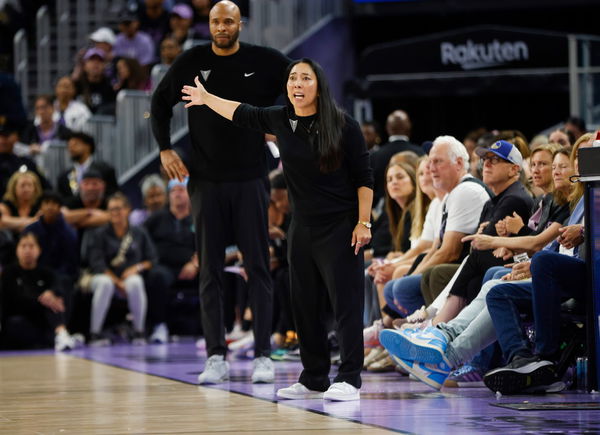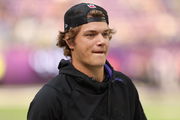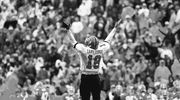
Imago
Jun 19, 2025; San Francisco, California, USA; Golden State Valkyries head coach Natalie Nakase yells during the third quarter against the Indiana Fever at Chase Center. Mandatory Credit: Darren Yamashita-Imagn Images

Imago
Jun 19, 2025; San Francisco, California, USA; Golden State Valkyries head coach Natalie Nakase yells during the third quarter against the Indiana Fever at Chase Center. Mandatory Credit: Darren Yamashita-Imagn Images
Each year, nearly 3,000 to 4,000 referees go through evaluations by the NBA’s scouting department, yet only a select few advance to the G League pipeline – the gateway to the pros. This feeder system doesn’t just test their physical readiness but also pushes them to master the rulebook and apply it with precision. It’s why Monty McCutchen, the NBA’s head of officiating, proudly calls them “the best-trained women’s officials in the world.” But if you ask the W’s 2025 Coach of the Year, she might not agree!
Watch What’s Trending Now!
And while Cathy Engelbert had already addressed the elephant in the room during All-Star Weekend in July, saying, “As we go forward on the officiating, we hear the concerns. We take that employee input… Every play is reviewed. We spend hours and hours and hours. Obviously, we use that then to follow up with officials’ training.” But clearly, the league’s efforts haven’t been enough. And that’s where Natalie Nakase steps in – to tell how it should really be done.
Speaking on the October 30 episode of “A Touch More” podcast with hosts Sue Bird and Megan Rapinoe, Nakase said, “I think number one, it starts with bettering yourself in the offseason. So right away, I would like to know what is their training? What are the requirements to be a WNBA ref? That’s kind of where I want to start because, like you said, maybe they’re just not at that level.”
ADVERTISEMENT

Imago
Shae Hammond/Bay Area News Group
She added, “I mean, the WNBA is the top. So how can we get better? Are they watching film? Are they studying? They need to also study the players too-how they move, how they maneuver-because then you kind of see like how players are getting extra calls or maybe even flopping… So I just think the training has to be at a level… I mean the players, the coaches, like we’re all doing things in the off-season. So I think that has to be there to raise the bar.”
Well, the Playoffs were a perfect example of what Nakase was talking about, especially Indiana’s 90–68 semifinal Game 2 loss to the Las Vegas Aces. That’s because in just two minutes into the game, the first of 43 personal fouls was called. What followed then were whistles that echoed through the Aces’ home court.
ADVERTISEMENT
“It’s very frustrating, very frustrating,” Fever head coach Stephanie White said post-game, calling out the officiating. And that wasn’t the only controversial moment.
In another playoff matchup, Nakase found herself on the other side of it. She earned a technical foul during her team’s 101–72 loss to the No. 1 seed Minnesota Lynx in Round 1. For Nakase, it was the referees who didn’t allow her team to play with the same physicality as their opponents.
ADVERTISEMENT
“I want a fair fight. I really do… I want a clean fight, but I love that both teams are playing their hearts out. They’re fighting. But I’d like it to be fair. And for me, that’s why I got a [technical foul], because at what point is it going to be fair?” she said during her post-game press conference.
She also emphasized that her team didn’t get the whistles they deserved, while Minnesota seemed to get the benefit of the doubt. Notably, the Lynx recorded 24 free throw attempts compared to the Valkyries’ 27, which was an increase from their regular-season averages of 16.1 for Minnesota and 18.4 for Golden State. Yet, that wasn’t enough to satisfy the first-year head coach.
Why? Because for her, it’s about balance and consistency. “We’re playing the best team in the league… They don’t need any help. This team is great. They’re stacked. They play well. They play beautiful basketball. They’re coached well. They don’t need the help,” she added. And she wasn’t wrong-just look back at the 2024 WNBA Finals Game 5, when the championship swung because of free throws.
ADVERTISEMENT
So yes, Nakase’s points are valid, especially her call for referees to study film and understand player movement. She’s right; many players take advantage of officiating tendencies to draw extra calls. As Megan Rapinoe added, “Players are smart-they’re going to manipulate and take every single advantage available to them. So you’ve got to be at that level too.” A fitting example? Breanna Stewart, often discussed for her high number of free throws. But now the real question is-will the league actually put these insights into action?
A look at existing rules and changes
Every year, a competition committee consisting of coaches, general managers, and members of the Board of Governors meets in November to discuss potential rule changes. Once the committee decides which changes it wants to propose, it presents them to the Board for a vote. That’s how the process works.
ADVERTISEMENT
But in the W, there’s already an existing rule that penalizes officials for repeated wrong calls. According to this rule, referees can be fined-not for a single missed call or one overturned by a challenge-but for showing a pattern of inconsistency. This directly affects their chances of advancing to the playoffs or receiving high-profile game assignments.
As McCutchen explained, “We’ve fined for misapplication of rules. We’ve fined for inappropriate behavior either with team personnel or, let’s say, online… We hold people accountable in various ways to their body of work. We have an ‘on notice’ program that if you get put on notice and your work does not improve, we move to separate from that arrangement.” So yes, the rules exist, but the real issue seems to lie in their implementation. Still, the question remains-will Cathy Engelbert take Nakase’s valid points into account?
Top Stories
J. J. McCarthy Awaits Punishment From Vikings After Rejecting Kevin O’Connell’s Instructions

Prayers Pour In as South Carolina HOFer QB Dies at 52

Patrick Mahomes Doesn’t Hold Back in Emotional Statement After Chiefs QB’s Troubling Knee Injury Update

Andy Reid Announces Patrick Mahomes’ Injury Diagnosis as Chiefs HC Doesn’t Hold Back After Playoffs Elimination

Dale Jr. Warns of Deeper Issues as Joe Gibbs Parts Ways With Decade-Long Executive

Chase Elliott’s Popularity Hits New Low as Dale Jr.’s Daytona 500 Return Triggers Record-Breaking Sale

ADVERTISEMENT
ADVERTISEMENT
ADVERTISEMENT

